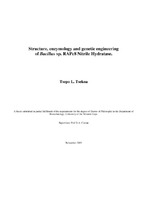| dc.description.abstract | Microbial nitrile hydratases (NHases) are important industrial enzymes that catalyse the conversion of nitriles to the corresponding amides. A thermostable, cobalt-type
Bacillus sp. RAPc8 NHase was previously cloned and expressed in E. coli. In this study, the primary aim was to determine the molecular structure of Bacillus sp.
RAPc8 NHase. The heterotetrameric enzyme was purified to near homogeneity using heatpurification, hydrophobic interaction chromatography and ion exchange chromatography. Purified NHase was crystallised using the hanging-drop vapourdiffusion method. Crystals produced in the presence of 30% PEG 400, 0.1M MES pH 6.5 and 0.1M magnesium chloride were selected for X-ray diffraction studies. These crystals diffracted well, with diffraction spots visible beyond 2.4Å, with little mosaicity. At 2.5Å, the data were 93% complete. The crystal structure of Bacillus sp. RAPc8 NHase was solved via molecular replacement using the crystal structure of Pseudonocardia thermophila NHase as a search model. The final refined structure had good refinement statistics and geometry. The overall fold was very similar to that of previously determined NHase structures. Bacillus sp. RAPc8 NHase was most similar to Bacillus smithii NHase (0.355År.m.s.d.) and least similar to Rhodococcus sp. R312 NHase (1.191Å r.m.s.d.). One
cobalt atom per heterodimer was bound to a typical NHase metal-binding motif, with post-translationally modified cysteine residues among the ligands to the metal.
The substrate-binding and catalytic cavity of Bacillus sp. RAPc8 NHase was identified and described in detail. Surface representation of the structure revealed an extended, curved solvent accessible channel with access to bulk solvent from two locations in the heterodimer. The amino-acid residues forming the channel were
identified and the geometric dimensions measured. Enzyme inhibition kinetics indicated that benzonitrile was a potent uncompetitive inhibitor of NHase. This information was used to aid the genetic engineering of aromatic substrate specificity into Bacillus sp. RAPc8 NHase. Site-directed mutants of NHase were prepared using the Quickchange mutagenesis procedure. Mutant W76G showed a two to three fold decrease in benzonitrile inhibition compared with the wild-type. Analysis of the substrate channel of this mutant NHase showed an 11% increase in volume and a 20% increase in inner surface area compared to that of the wild-type NHase. Due to the lack of other significant differences between the two structures (an r.m.s.d. of only
0.101Å was observed), this difference was thought to be responsible for the decrease in benzonitrile inhibition. A structure-modelling based approach for assessing the
likely structural differences that may result as a result of a specific mutation was suggested and tested. This approach may be of value in future mutagenesis work. | en_US |

